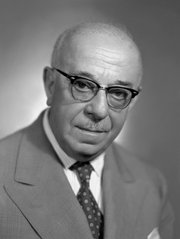Agostino Pennisi di Floristella
Agostino Pennisi Statella, Baron von Floristella (born August 10, 1890 in Acireale , † August 19, 1963 ibid) was an Italian numismatist , collector and politician.
Life
Agostino was born in Sicily as the eldest son of Salvatore, Baron von Floristella and his wife Gabriella Statella . In a self-portrait from November 4, 1911, he showed himself as an elegant young man in the autumn light. He corresponded with the New Provencal poet and Nobel Prize winner Frédéric Mistral and completed his literary studies in Catania and Pavia in 1912 with a doctorate on the legend of the holy Thais . A year later his rhymed morning song was printed in Acireale . An oriental triptych followed .
On June 4, 1914, he married Agata Fràncica-Nava, with whom he had nine children. In 1916 he and his brothers Antonio and Giuseppe were called up. He had to leave his second son, Orazio, who had just been born, to serve in the Third Army on the Isonzo with the rank of lieutenant. As a driver in the rescue service of the Red Cross, he worked on the wide Friulian theater of war from Cervignano del Friuli to Begliano and from Turriaco to Versa, Vertoiba and to Bainsizza. Practiced in recordings of numismatics , Agostino Pennisi led a photographic diary with a small Kodak camera. During the war, between the summer of 1917 and the autumn of the following year, he exposed 199 roll film negatives that captured moments in the lives of soldiers and civilians in the immediate vicinity of the front. On November 9, 1918, he made his way back from Carpenedo to his family.
Pennisi was considered to be a connoisseur of Greek-Sicilian coinage. In 1931 he inherited from his father as a family property coinage from Syracuse from the sixth to fourth century BC, gold pieces, including a unique one with the Greek inscription "Messenion" related to Messina , silver tetradrachms from Naxos, Palermo, Agrigento and Kamarina. Richard Wagner, Prince Karl of Prussia and Archduke Karl of Austria had once come to Acireale to admire them. Today they are in the National Museum of Syracuse.
On June 15, 1933, he paid tribute to the poet Lionardo Vigo Calanna (1799–1879), who described Sicilian folk culture as early as the middle of the 19th century. He reported new coins in his collection to the Royal Academy of Sciences and Arts in Acireale on June 12, 1934. In 1943 he became Prefectural Commissioner of Acireale, in 1946 elected President of the Academy, in 1948 he was elected to the Senate for the 1st legislative period , again in 1958 for the 3rd and in 1963 the 4th legislative period, in which Giuseppe Molinari succeeded after his death . He was also an appraiser for the Ognina treasure trove. In 1954 the German Archaeological Institute appointed him a member.
Publications
- Mattinata. Versi. sn, Acireale 1913.
- Trittico Orientale. Idilli biblici. sn, Catania 1914.
- Agostino Pennisi Floristella, Agostino Pennisi Statella - Frédéric Mistral, Carteggio 1911–1913, PDF file (1.4 MByte, Italian).
- Taccuino fotografico di guerra. Edizioni del Consorzio culturale del Monfalconese, San Canzian d'Isonzo 1999.
- Una Canzone di Gesta in Pieno Secolo XIX., Acireale 1933 PDF file (1.8 MByte, Italian)
literature
- Enrico Mauceri : Acireale e il Medagliere Pennisi. In: Emporium. Vol. 35, No. 205, January 1912, ZDB -ID 216240-4 , pp. 213-223 , (Italian).
- Felice Saporita: Per la storia del Monetario Pennisi di Floristella. In: Accademia di Scienze, Lettere e Belle Arti degli Zelanti e dei Dafnici Acireale. Memorie e rendiconti. Series 4, Vol. 10, 2000, pp. 293-319, ( PDF file (790 kByte, Italian)).
- Christof Boehringer : Reconstruction of the treasure trove of Ognina 1923. Agostino Pennisi Barone di Floristella in memoriam. In: Swiss Numismatic Review . Volume 57, 1978, 102-143, doi : 10.5169 / seals-174370 .
| personal data | |
|---|---|
| SURNAME | Pennisi di Floristella, Agostino |
| ALTERNATIVE NAMES | Agostino Pennisi Statella, Baron of Floristella |
| BRIEF DESCRIPTION | Italian folklorist and politician |
| DATE OF BIRTH | August 10, 1890 |
| PLACE OF BIRTH | Acireale |
| DATE OF DEATH | 19th August 1963 |
| Place of death | Acireale |
